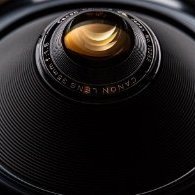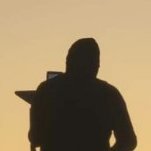-
Posts
594 -
Joined
-
Last visited
About Jay Young

- Birthday 04/16/1982
Profile Information
-
Occupation
Gaffer
-
Location
Atlanta
-
My Gear
Huge array of Tungsten, all of the latest LED lamps
-
Specialties
Tungsten Hard Lighting
Contact Methods
-
Website URL
Jay-CLT.com
Recent Profile Visitors
19,245 profile views
-

Pre-lighting - Any suggestions?
Jay Young replied to Nicolas U Hepburn's topic in Lighting for Film & Video
The lighting comes from the same place as the music. It doesn't have to BE motivated to feel motivated. You're likely overthinking. However, if you're not happy, we're not happy. So looking at your pictures, with the single on the camera left, the source is too high. Its lighting the top of his head. Great if you want a top light, but I think if you lower it down, and maybe even reduce the output, you'll have a better feel for what you are trying to achieve. -
Usually film is a bit slower, and when shooting at 320asa its a lot easier to make things moody. These days, with cameras at the more sensitive end of the spectrum, its been quite challenging. As others have said, even at -4 stops, you'll still see the wall. If you want it to be black, you'll have to have quite a bit of control.
-

Best recommendation for an led lighting package.
Jay Young replied to Erik Baczay's topic in Lighting for Film & Video
Do you need tubes? Do you ever use the individual tubes? If you do, then there are plenty replacements out there, just pick one, they are mostly the same. As far as innovative products that might work for you: Aputure Infinibars: A linear lamp which can be put in a softbox. I really like these fixtures. These are square, not tubes, and will not fit in a kino housing. Aputure Infinimat 1x4 size: This will mimic the same footprint size as your kino fixtures with more output. Amaran F21c / F22c: The f22 is a flexable matt light which, with the diffusion installed, follows the plank curve for white light with as little as 0.008 deviation past 5600k - its almost perfect. I really like this fixture also. This was the R&D test lamp for the Infinimat, so the emitters are the same. Really useful product! Nanlux PavoSlim / Kino Freestyle, Celeb: Depending on your budget, these may work, they are panel lamps in small footprint that are really quite useful. I love the freestyles, and they make a size that is close to a 4 bank. You might be able to pick one up on the used market. Output wise, unsure. Finally don't forget about DMG Maxi Mix - a 4x1 panel, which should output the same as a kino 4 bank. I've never tested that particular comparison, however I love the DMG fixtures, never had an issue. Very easy to deal with. Godox makes some mat lights which are flexable, and in various sizes. They will all fill in for kino fixutures, but usually will be physically larger. Amaran, Nanlite, Allidan, Intellytech, and others all make about the same products, so find one that fits your budget and has the features you need. Beyond Creamsource, Arri, and Fiilex, we do use both Aputure and Nanlux fixtures on the big shows. At this point, it really depends on what the tool is. HOWEVER - Let me say this. LED's are not perfect. They each have their issues. Color wise, Creamsource and Fiilex make just about the best lamps. Fluorescent lamps produce a more complete spectrum, and for some markets (beauty / fashion / product) may actually be the better option, depending on the post workflow and desired outcome. -

How was this hall lit? (Blue Jean, 2022)
Jay Young replied to Aidan Brook's topic in Lighting for Film & Video
Kubrick did a similar thing on stage, and I think today you have a choice of tools. Budget not withstanding; you can but a bunch of 12-light maxi's out the windows, perhaps with some blue gel to cool the color; 18k's or your choice of large fixture with diffusion over the window. You could choose an LED mat very close to the window, and then raise the ambience from inside. You could bounce real sun into the window with mirrors and diffusion depending on the weather. I would definitely choose one of the first options, large lights from outside. That way is always consistent. One can argue about tenting the windows, but so long as you don't see out them, the changing day ambience shouldn't matter too much, unless you are forced to shoot with a very sensitive camera.- 2 replies
-
- lighting
- ambient light
-
(and 1 more)
Tagged with:
-

WSJ What Makes IMAX So Expensive?
Jay Young replied to David Sekanina's topic in 65mm / IMAX / Iwerks
I may be an out of work IATSE member, but for me, IMAX has always been more about the presentation than production. Certainly 15p projection is a spectacle. In the proper setting it can be a wonder to behold. However, at my local AMC, IMAX means nothing more than a larger screen, and sound pressure levels so high it physically hurts. People walk out of shows because the sound volume is so great. This is not a "fun" entertaining experience, its perhaps something one can't get at home, but most assuredly a money grab from cinema owners because of branding. After the past years experiences, I will not attend an IMAX showing if it is not traditional presentation. I have heard the arguments made about the audio, even that mixing engineers mix at 130+ dB. Impossible, they would permanently damage their hearing. Rumors that Mr. Nolan prefers his explosions to be lifelike even in the theatre. Nonsense. Cinema managers state they have no control over the volume. Utter garbage. There is a single dial, usually set at 7. Turn it down. That is to say nothing of the actual visual presentation, which is lackluster. I notice no difference between the normal projection of digital shows, and the much hyped laser systems. Perhaps there are a handful of cinemas that care about presentation, but they are far and few between. Having seen the roadshow presentation of Hateful8, I was quite pleased. Having seen a 70mm showing of 2001 gave critical insight into the film I had never experienced. Having seen the rest of the so called IMAX shows in properly branded theatres, I can say I would have much more enjoyed being at home, watching on my hi-fi with the two speakers. Presentation needs to change. -
We move S60's on combo stands daily. I'm sure we would try to move a s360 if it was more compact. Anything that doesn't have a header cable really, we will pick up and move unless its going through a door. A lot of the smaller budget shows with inexperienced DP's think its saves time to do things a certain way. This usually is a result of no planning and making everything up on the day. Larger budget shows, even with only three or four electricians on set are much more manageable. Safety becomes something people talk about, both personal and equipment.
-
Once somewhere here there was discussion about using an 85 filter or not. The conclusion was that while technically the density changes between the two options are different, if you don't need exact color critical exposure then not using the filter can easily be corrected in DI. Sounds like you are set to use filtration, so not something you need to worry about.
-

The Perfect Interview Key Light - Godox F600Bi
Jay Young replied to Tim Tyler's topic in Lighting for Film & Video
I think, technically, with the amount of technology available, I would be happy wiring a 48v solar array, or a few lithium batteries direct to one of these batteries. The only hard part is crimping the connection, or finding a compatible male connector. Having built several of my own solar/battery power solutions this past year, the pieces are cheap, readily available, and easy to use. Paying a convenience factor to EcoFlow or PortablePower to put everything in a box for you may not be the best use of funds. Now, I realise I'm a gaffer with the technical knowledge to do this, and not everyone wants to go down that road. I feel like eventually, AC or DC it won't matter. Just plug it in and go. Which makes me think we are coming full circle. -

What fixture is really light these scenes?
Jay Young replied to Wenqi Wei's topic in Lighting for Film & Video
I agree with David and the rest, it seems like a large, soft, overhead source. -
I think this particular DP was scared there wasn't enough level. I lit the background outside windows with several LED lamps through VS Cyan at 20% intensity. There was plenty of room to go up. I am not really sure why that choice was made, but we dealt with it as usual. As far as I recall, all of the daytime EXT was shot at 800 with internal ND's as needed, and a pretty healthy stop. I didn't add anything except a bounce for closeup work. Yes I always carry ND for those times we need to dim from "0%". This is something I run into more often with inexperienced DP's. High iso shooting means they don't need so much level in the room, but it causes more problems than it solves, in my opinion.
-
I have been a tungsten fan for a long time. I always carry tungsten on the truck. However, I see two things happening from my experience that will color the future. On the one hand, depending on budget, small independent features may not be able to afford led lighting packages, however I have shifted small fixtures over to led because I can now get a good enough 650 replacement. That color science will get better, and I believe can replace tungsten lamps up through 2000w of output. Beam patterns are getting better, as is color accuracy. On larger budgets or studio shoots where there is a green mandate, we might be asked to run as much as 70% led. This is problematic because even above $10m, that get expensive really fast. Zips still go in the perms because soft panels can't be ordered in sufficient quantity to meet the budget requirements. Productions can either meet their green mandate, or their budget line costs, not both. At some point, this will change and I have no doubt that LED's will get cheaper. Again this is why I often carry a mixture of small LED fixtures, and small tungsten fixtures. But David reminds us of something I talk with Aputure about often, the 10k problem. Making a big soft source out of LED's is easy. Making a 20k point source is not. There are several manufacturers working on the issue, but the technology does not exist yet. The second thing is camera sensitivity. A lot of lower budget shows, even shooting on the Venice, choose to shoot at 4000 iso. I cannot tell you the number of problems this creates for the gaffer. I constantly ask DP's not to do this. On set yesterday, I had 4 litemats, a few tubes, a few other fixtures, and nothing was above 8% on the dial. The levels were so low the actors were complaining they couldn't see where they were going. On camera, it looked like bright daytime. I asked the DP if they wanted to raise the level in the room, and close down a stop for the sake of talent, and was denied. I am 100% sure closing down from 1.8 would have made no difference in the quality of this film. I had enough light in the room to raise the whole thing 2 stops, but that's the way young DP's have been cultured to shoot. Suddenly, tiny sources contaminate the scene, and I have to cover status LED's on control panels! 800iso is fine, but I feel we really need to get away from pushing camera technology in this particular direction. If we shoot everything at 10,000 iso, we won't need to solve the 10k problem..... Food for thought, and just my opinion.
-
That's pretty normal. 8x rags tend to come with at least two floppies, or four, or it can get real big with big pieces of duve wrapped around the whole thing. Yes, your experience is normal.
-

light bulb sockets for batten lights
Jay Young replied to Johanan Pandone's topic in Lighting for Film & Video
You could probably use the plastic sockets with a little black wrap heat shield if you wanted a higher wattage bulb. I've been having a great difficult time finding affordable porcelain sockets - if stores have them at all these days. I've used plastic to build all of my battens in recent months. -

Question about Aperture LED vs HMI's comparison
Jay Young replied to Kyle Farscht's topic in Lighting for Film & Video
To answer some questions, after three shows using nothing but Aputure products, I can say that if one already owns HMI lamps, use them. They still work. My current show I have 4x joker 400w, and 4x joker 800w - they have never been out of the case. The DP insisted that we have them...... wasted money. The Aputure and Nanlight 1200w lamps are factually the same output as an M18 at about 30% cheaper to purchase. But there are drawbacks: The header cables have a finite length, of which I have sent my disdain to the engineering department. They advise there is too much voltage drop over distances longer than 25 feet to efficiently run the led engines. Well, I call bullshit on that. Engineers are always a wee bit conservative. They will figure it out. With a ballast and lamp head the size of the 1200w fixture, there is plenty of room to shove more lighting in. I don't know how many hours it takes for one of these lamps to color shift appreciably, because they are so new it has not happened yet. I own 4 600D's, and a 1200. They work all the time, and I have yet to see, on camera, an issue. This may have been an issue with older lamps, but the new hardware is pretty solid. Now we can argue that an 800w joker with spotlight attachment puts out more footcandles than an equally outfit 600d, but I would argue that one should choose the right tool for the right job. I am sure there are Gaffers and DP's which would need the extra few footcandles in certain situations where the output difference would make or break a shot. However, I'm not so certain that it would make all that much of a difference. Things will continue to evolve and the engineering will get better. Something must absolutely be done about the F35 fresnel, which is WAY too heavy, and creates serious danger problems on set. Anyhow, Aputure, at least for now, seems to be headed in the right direction.






